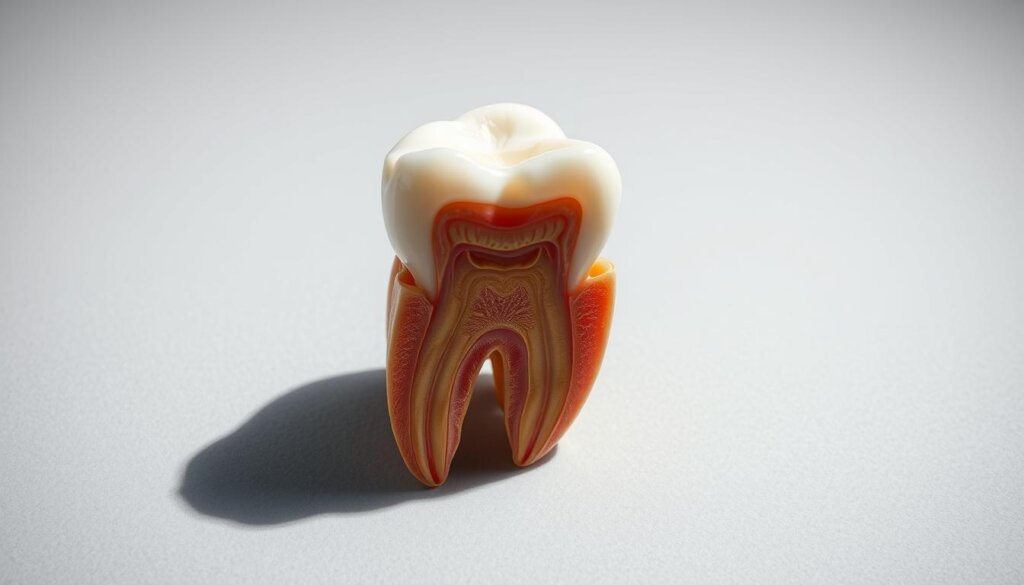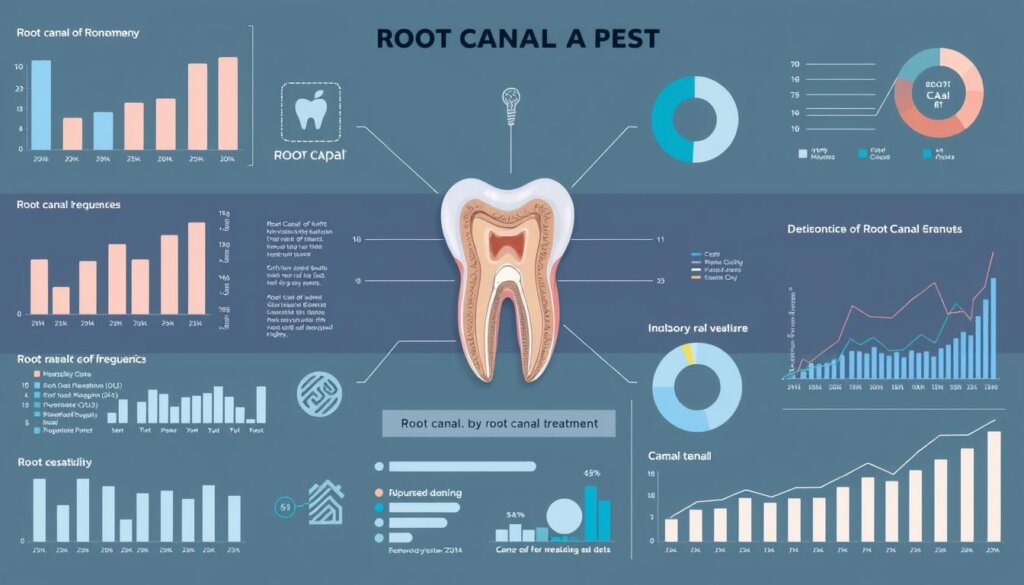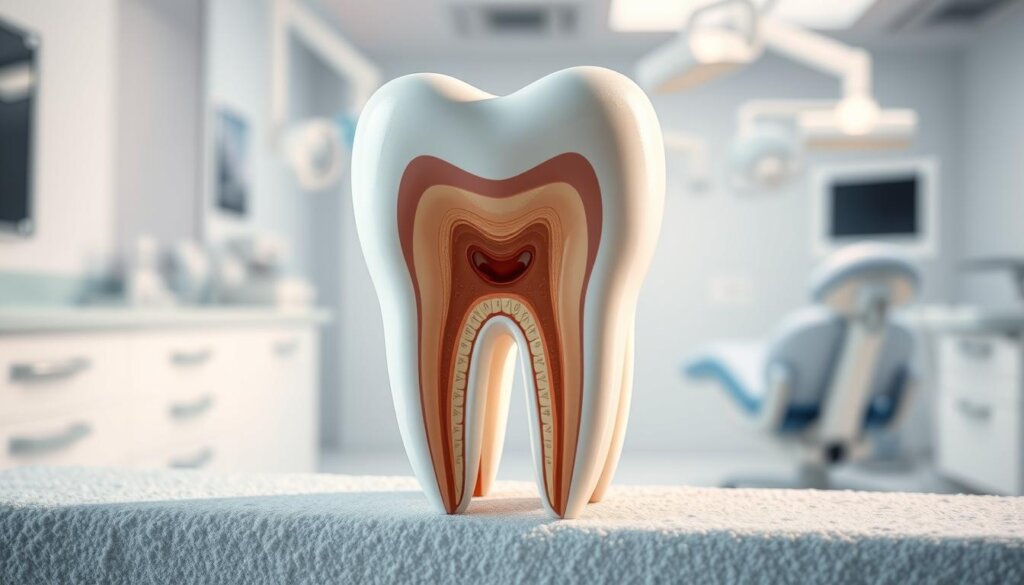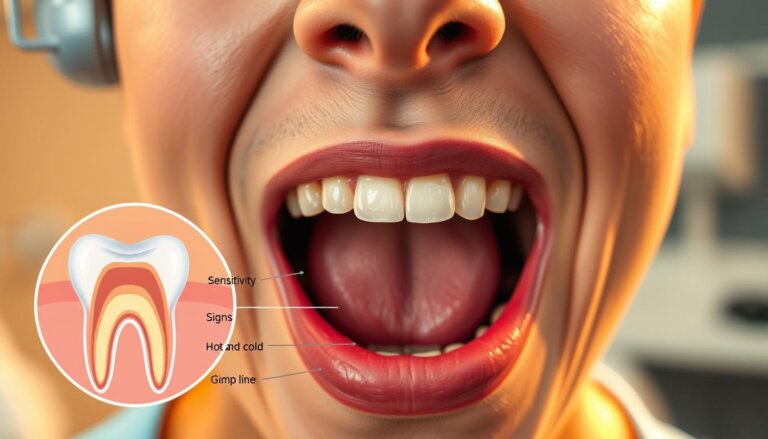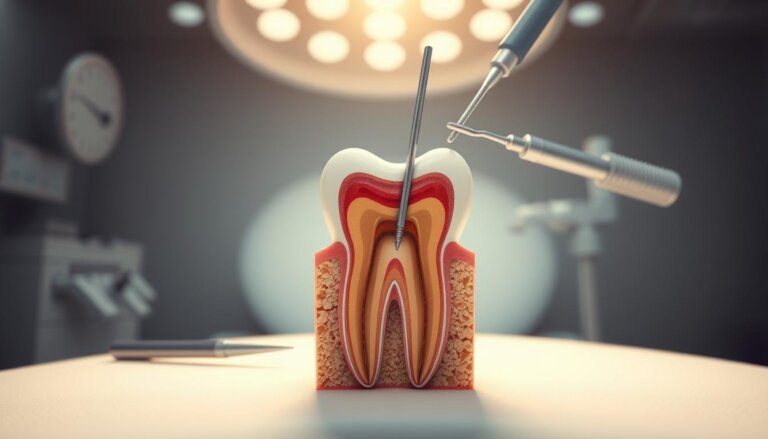Does a Root Canal Treatment Remove My Tooth Roots or Kill the Tooth?
Every year, over 15 million people in the U.S. get root canals. But many are curious: does it remove tooth roots or kill the tooth? This part explains what root canals do. It shows how modern dentistry keeps your natural tooth safe while fixing infections inside.
Keeping tooth roots safe is key for good oral health. Root canals remove the bad pulp but not the whole tooth. This makes your tooth last longer and saves you money on new ones. It’s a science-backed way to keep your teeth working well for years.
Key Takeaways
- Root canal therapy removes infected pulp but keeps tooth roots intact.
- Maintaining natural tooth structure lowers the risk of future complications.
- The procedure combats infection through precise endodontic techniques.
- Retaining the tooth often prevents the need for implants or bridges.
- Regular check-ups further protect overall dental health.
Understanding Root Canal Treatment
This treatment aims to fix internal infections without harming the tooth’s outside. Dentists remove damaged pulp, clearing out bacteria. This way, the tooth can stay in place. It’s a key choice for keeping your teeth functional and avoiding tooth loss.
What is Root Canal Therapy?
Root canal therapy removes diseased pulp and seals the tooth to stop future infections. Thanks to modern tools, this process is now more precise and less painful. Dentists use images and gentle methods to make sure you’re comfortable.
- Infection Removal: Damaged tissue is cleaned out.
- Sealing: A specialized material guards against bacterial return.
Why Is It Necessary?
The inside of a tooth has nerves and blood vessels that keep it stable. When bacteria get in, it can cause deep pain and abscesses. Getting treatment early helps keep your tooth intact and controls infection risks.
“Root canal therapy is a proven method for stopping the spread of decay and maintaining oral health.” — American Dental Association
The Structure of a Tooth
Dental experts say healthy teeth need different layers working together. A tooth has an outer layer of enamel, a middle layer of dentin, and a pulp at the center. This pulp has nerves and blood vessels that help feed the tooth.
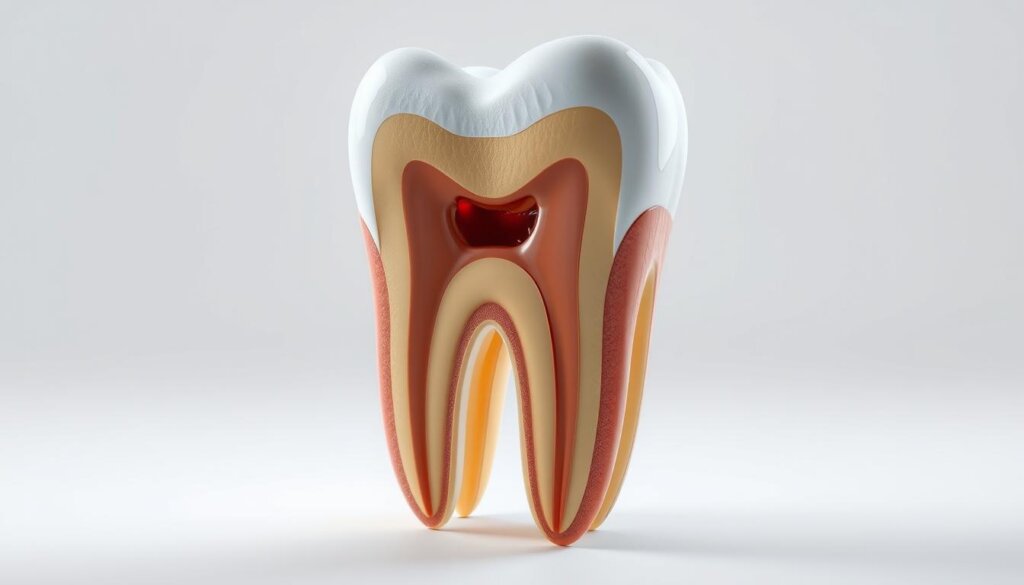
Anatomy of Teeth
Enamel keeps teeth safe from bacteria and wear. Dentin helps us feel pressure and shock. The pulp, with its nerves and blood vessels, keeps the tooth alive and working right.
When doing a dental root canal, doctors try to keep this pulp safe. They want to save as much of the tooth as they can.
Functions of Tooth Roots
Roots hold each tooth in place, making sure we can bite and chew without problems. They send important signals through canals, helping us feel pressure and any signs of trouble. Keeping roots healthy is good for the jawbone, as it helps prevent bone loss.
| Part of Tooth | Description |
|---|---|
| Enamel | Hard protective layer |
| Dentin | Shock-absorbing middle layer |
| Pulp | Vital center with nerves and vessels |
| Root | Anchoring structure in the jaw |
How Root Canal Treatment Works
Endodontic therapy aims to remove inflamed pulp while protecting the tooth’s core structure. This process starts with local anesthesia and a precise opening through the crown. A trained endodontist or dentist then clears away damaged tissue, cleaning each canal to create a sterile environment.
Steps Involved in the Procedure
Patients often wonder what happens once the tooth is numbed. The sequence typically includes:
- Creating a small access point in the coronal portion
- Removing infected pulp tissue using sterilized instruments
- Shaping and flushing canals to eliminate bacteria
- Sealing canals with materials like gutta-percha
- Placing a protective restoration over the tooth
Tools and Techniques Used
Modern digital imaging, rotary devices from brands such as Henry Schein, and surgical microscopes all enhance visibility and precision. The American Dental Association recognizes these technologies for improving patient outcomes. Procedures involve careful use of irrigation solutions, rubber dams, and specialized filling substances that help preserve function and comfort. This blend of innovation and skill helps ensure a dependable result for many dental cases.
Does Root Canal Treatment Remove Tooth Roots?
This special procedure takes out infected tissue but keeps the outer root structure. Dentists remove diseased pulp from the canals and seal them. This helps keep the tooth stable.
Explanation of Root Preservation
Dentists aim to keep tooth roots stable. They remove inflamed material, not the whole root. This keeps the bite right and bone density healthy.
Role of Tooth Roots Post-Treatment
Even after the pulp is gone, roots keep the tooth in place. Sealing the canals properly ensures the tooth’s support lasts. This means balanced chewing and a stable jaw, showing the long-term benefits of keeping roots intact.
Does Root Canal Treatment Kill the Tooth?
Dental experts often face concerns that root canals kill teeth. This procedure removes the inflamed pulp but keeps the tooth’s structure intact. It offers relief and lets patients keep their natural tooth for daily activities.
Impact on Tooth Vitality
The treated tooth loses direct nerve access but stays anchored by living tissues. Blood flow in the jawbone keeps the area stable. This balance ensures the tooth can function normally for chewing and speaking.
What Happens to the Tooth Post-Treatment?
After treatment, the hollow space is sealed to block bacteria. Dentists often suggest a crown for extra support. The tooth can handle daily forces and supports other teeth, helping maintain a healthy bite.
Risks and Benefits of Root Canal Treatment
Root canal therapy saves natural teeth and stops more serious problems. Many people worry about side effects. But, today’s methods and cleaning keep big issues rare.
Common Risks Involved
Minor swelling and some tenderness can happen. If bacteria hide, the tooth might get infected again. Also, calcification in canals is possible, but scans help catch it early.
These issues are rare with good cleaning and sealing.
Long-Term Benefits
Keeping a natural tooth helps your bite and supports your mouth. It stops jawbone loss and cuts down on future dental work. Many feel better and chew easier after the treatment.
The treated tooth looks and feels like your own, making daily life easier.
| Risks | Management |
|---|---|
| Discomfort | Use recommended analgesics |
| Reinfection | Follow strict oral hygiene |
| Blocked Canal | Employ advanced scanning methods |
Signs You May Need a Root Canal
Early signs often point to serious dental issues that need expert attention. Persistent pain can mean deep infection and nerve damage. This might need advanced treatments.
Symptoms Indicating a Problem
Common signs include:
- Lingering sensitivity to temperature changes
- Continuous toothache disrupting daily tasks
- Swollen or inflamed gums near the affected tooth
- Notable tenderness when biting or chewing
Importance of Timely Treatment
Ignoring these signs can lead to abscesses or tooth loss. Quick action through targeted treatments protects your teeth. It also prevents severe decay.
Acting fast often lets dentists save your natural tooth roots. This reduces the chance of long-term pain. It also helps keep your mouth healthy for years to come.
Alternatives to Root Canal Treatment
When a tooth is damaged, people look for other dental options. Keeping the natural tooth can make it more comfortable and help with chewing. Making the right choice is key to keeping your teeth healthy for a long time.
Tooth Extraction vs. Root Canal
Extraction takes out the bad part of the tooth. This stops the infection but might change the jawbone over time. It can also cause gaps in your teeth, changing how you chew.
A root canal keeps the tooth intact. This means you can chew and talk normally without any issues.
Other Treatment Options
Dentists might suggest pulpotomy or pulpectomy for some cases. Others might recommend dental implants or bridges for more serious damage. Each option needs careful thought and a dentist’s advice before choosing.
Aftercare Following Root Canal Treatment
Many patients ask how to protect their tooth after a root canal. Good habits are key to keeping the tooth strong and free from problems.
Initial Recovery Guidelines
Soreness may last for a bit. Taking care of it right helps ease pain and keeps the tooth from getting stressed.
- Use over-the-counter medications as recommended by a dental professional.
- Chew on the opposite side until the final restoration is placed.
- Brush gently and avoid vigorous rinsing during the early healing stage.
Long-Term Dental Care
Keeping up with dental care is important. Regular check-ups help catch any issues early.
- Schedule periodic checkups to evaluate filling stability.
- Adopt a diligent brushing and flossing routine at home.
- Report any persistent sensitivity or discoloration immediately.
| Action | Frequency | Benefit |
|---|---|---|
| Professional Cleaning | Every 6 Months | Removes plaque and safeguards treated tooth |
| Dental Examination | At Least Once a Year | Identifies early signs of new decay |
| Fluoride Application | As Advised by Dentist | Strengthens enamel and reduces sensitivity |
Can a Tooth Survive Without a Root Canal?
Some think teeth can heal if early infection goes away, thanks to the immune system. This happens sometimes, but it’s not common. It doesn’t usually stop deep bacterial growth.
Natural Healing Processes
Dentin cells try to protect the tooth by releasing protective factors. If the damage is minor and bacteria stay on the surface, it might heal. But, if decay goes deep, it can spread to the root canals and bone.
Risks of Inaction
Not treating a tooth can lead to more problems. Deep decay can cause:
- Chronic pain that gets worse
- Potential abscesses in soft tissues and bone
- Irreversible damage that might need extraction
Seeing a dentist is usually the best way to save a tooth once damage is severe.
Frequency of Root Canal Treatments
Experts usually do root canals only once on a tooth. Rarely, a tooth needs another treatment if the first one was done right and oral care is kept up. But, problems can happen if something outside affects the tooth’s structure.
Going to the dentist regularly helps catch problems early. This includes finding hidden parts of the tooth that weren’t seen the first time. It shows how important it is to get regular cleanings and take good care of your teeth yourself.
How Often Are They Needed?
Many people don’t need another root canal after the first one heals. Some go years without needing another one. Good results come from proper restorations and keeping up with brushing, flossing, and eating well.
Factors Influencing Treatment Frequency
Getting hurt can reopen canals or cause new infections. Doing a lot of fillings or crowns on the same tooth can mess with the first treatment. If a canal is missed, bacteria can grow, leading to infection again.
| Condition | Likely Interval | Reason |
|---|---|---|
| Healthy Tooth Post-Procedure | Rare or None | Quality seal and diligent care lower reinfection risk |
| Injury or Hidden Canal | Possible Re-treatment | Structural damage or undetected anatomy may trigger issues |
| Multiple Dental Procedures | Varies | Frequent manipulation can compromise the treated area |
Cost of Root Canal Treatment
Choosing root canal therapy can save money in the long run. It avoids the need for expensive implants, dentures, or bridges. Many people prefer to keep their natural teeth for better stability.
Average Costs in the U.S.
Prices change based on the tooth’s location and how complex the treatment is. Front teeth are usually cheaper because they’re simpler. But, back teeth, or molars, cost more because they’re more complex. Getting a precise price usually needs a dentist’s check-up.
| Tooth Location | Estimated Cost Range |
|---|---|
| Front (Anterior) | $600 – $1,100 |
| Premolar | $700 – $1,300 |
| Molar | $800 – $1,500 |
Insurance Coverage Options
Some dental plans help pay for root canals. Dental offices might also offer payment plans to spread out the cost. Looking for in-network providers can help get a better idea of what to expect.
- Consult individual insurance policies for exact reimbursement
- Ask about flexible financing at local dental offices
| Coverage Type | Potential Benefits | Key Consideration |
|---|---|---|
| Employer-Sponsored Plan | Partial Coverage | Varying deductibles |
| Private Insurance | Negotiated Rates | Annual limits |
| Payment Plans | Flexibility | Credit checks |
Finding a Qualified Endodontist
Finding the right specialist is key for a successful root canal. An experienced endodontist has the education and skills needed for complex cases.
Importance of Experience
Experts with a background in endodontics often avoid complications. They use special tools and imaging to handle tough cases. Their years of practice make treatments less painful and help with healing.
Credentials to Look For
Look for specialists from top dental schools and with extra certifications. Being part of groups like the American Association of Endodontists shows they keep up with the latest. They also use the latest digital radiography to make accurate diagnoses and save teeth.
| Credential | Why It Matters |
|---|---|
| Advanced Training | Ensures mastery of complex root canal procedures |
| Professional Affiliations | Guarantees adherence to current standards and ongoing education |
| Use of Modern Technology | Strengthens diagnostic precision and promotes efficient treatment |
Myths and Misconceptions About Root Canals
Root canal therapy often gets a bad rap. Many think it’s super painful or harmful to health. This fear stops people from getting the care they need.
Common Misunderstandings
Some believe root canals hurt more than the original tooth problem. But, thanks to new methods and anesthesia, pain is much less. There’s also a myth that root canals can cause serious diseases like heart problems or dementia. But, studies show no link.
Clarifying the Truth
Today’s dental tools and skilled dentists make root canals safe. They remove bad bacteria without harming good tissue. Plus, strict cleaning methods make the treatment even safer.
| Myth | Reality |
|---|---|
| Root canals are extremely painful | Today’s anesthesia significantly reduces discomfort |
| Treatment causes health issues | No credible data links root canals to widespread illnesses |
| Removing the tooth is safer | Preserving the natural tooth promotes better long-term function |
Conclusion on Tooth Health and Root Canals
Root canal therapy stops infection and saves the tooth. It reduces pain and keeps the tooth working well. This method removes the damaged pulp but keeps the tooth’s outer structure.
Summarizing Key Points
Acting quickly is important. Signs like pain, swelling, or sensitivity mean trouble. A root canal keeps the tooth’s roots healthy for chewing.
It removes diseased tissue and seals the canal. This makes the tooth safer for healing. Taking good care of the tooth after treatment helps it last longer.
Final Thoughts on Treatment Necessity
Endodontic services are a good choice for tooth preservation. Modern tools and materials help endodontists work accurately and safely. If you have ongoing pain or discomfort, getting checked is key to saving your tooth.
This treatment helps keep your mouth healthy and relieves pain for good.

